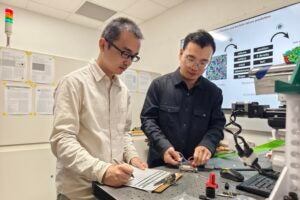Some students trek through canyons noting rock formations. Others fix problems by creating new products.
Some teachers share a curriculum to introduce high school scholars to engineering. Future teachers instruct pupils in the classroom. And others teachers use colorful videos to spark ethics debates.
Initiatives that started at The University of Texas at Austin are shaping the future of education, preparing tomorrow’s leaders and taking Longhorn expertise beyond the Forty Acres. Five programs are helping students succeed and equipping teachers with innovative resources. Learn more about UTeach, Idea2Product, GeoForce, Engineer Your World and Ethics Unwrapped.
UTeach

What Is It?
UTeach enables undergraduate students to earn a degree in a science, technology, engineering or math (STEM) field while also completing a secondary teaching certificate, paving the way for graduate school or a career in either a STEM field or teaching.
“Half of the people who graduate with us weren’t thinking of teaching when they arrived,” says Michael Marder, director of UTeach Natural Sciences. “They get in a room full of kids and realize this is what they were born to do.”
The UTeach program brings college students to elementary and high school classrooms to begin the process of becoming a teacher with hands-on experience under master teachers.
“The biggest problem with the entire K-12 public schooling system is the absence of science and math qualified teachers,” Marder says. “The best and most important thing a university can do to assist public education is to prepare as many of those teachers as possible.”
Nearly 900 UT students have completed UTeach, 90 percent of whom enter the K-12 teaching profession. Of those students, 80 percent remain in the teaching field five years after graduation.
Beyond the Forty Acres
A collaboration between the Colleges of Natural Sciences and Education, UTeach was established in 1997. In 2006 the program was expanded nationally, and the model is now being used at 38 other universities.
As part of Georgia’s Race to the Top plan, the Governor’s Office of Student Achievement awarded grants as much as $1.4 million to Columbus State University, Southern Polytechnic State University and the University of West Georgia to replicate the UTeach program there.
In Georgia alone, officials expect graduates of the UTeach programs in Georgia to then go on to teach STEM courses to 160,000 secondary students by 2020.
Idea to Product

What Is It?
Idea To Product, or I2P, is an international, student-led competition for early-stage technology commercialization. Students from across disciplines come together to create new products that solve problems and fill a market need.
Professor Steven Nichols, I2P’s director, says students from engineering, natural sciences, law and business learn the fundamentals of bringing an idea to the market in a course where teams develop products for I2P.
“Instead of how to start a business, we’re trying to teach how to create a new product or service,” Nichols says. “We ask if we’ve solved a problem for anybody else.”
The competition forces students to look at the product’s market potential. Winning entries are unique, innovative, feasible to implement and address a clear need.
[Read more about great ideas and products that started at The University of Texas at Austin]
Beyond the Forty Acres
Started in 2002, I2P originally filled what Nichols calls an “education hole.” Today it’s an independent entity that hosts specialized competitions across the country. Teams from 63 universities have participated in I2P competitions on five continents.
California State University’s Program for Education and Research in Biotechnology, hosts the Annual CSU Biotechnology Symposium, where its CSUPERB I2P competition culminates.
“One hallmark of the I2P program is that students with no previous experience in biotechnology commercialization can be competitive,” says Susan Baxter, CSUPERB executive director.
GeoForce Texas

What Is It?
GeoForce Texas takes high school students into the field to learn about geosciences and prepare for career opportunities.
Students from minority-serving and inner city-high schools travel on “geologic field trips” to study geosciences in person at McKinney Falls State Park, Florida beaches, volcanic formations on the West Coast and the deserts of Arizona and New Mexico. During these trips, students build a foundation for future geosciences education.
GeoForce Texas alumna and current Jackson School senior Victoria Fortiz says the program pushed her to study geological oceanography.
“Before GeoForce, I didn’t know what geology was,” says Fortiz, a first-generation college student from Eagle Pass. “GeoForce gave me my career path.”
By bringing high-school students into the wild to learn, GeoForce Texas takes aim at two problems underserved students not reaching full potential and a shortage of new workers entering the geosciences field.
Housed in the Jackson School of Geosciences, GeoForce Texas takes 600 students every summer on the annual field trips. Students begin the program in ninth grade and continue every summer until graduation.
“They’re learning how to do science,” says Samuel Moore, director of outreach and diversity in the Jackson School of Geosciences. “They’re working with the research scientists and looking at formations. They’re coming up with a hypothesis and looking for evidence in layers of sediments.”
Beyond the Forty Acres
Founded in 2005, GeoForce Texas boasts a 100 percent high-school graduation rate among participants, and two-thirds of the students have gone on to enter a STEM field.
The model is so successful that GeoForce Alaska (at the University of Alaska Fairbanks) has replicated the program with high school students there.
“The students will tell you this program has changed them,” Moore says. “It helps them to make an informed choice about a career in STEM and in geosciences.”
Engineer Your World

What Is It?
Engineer Your World is a yearlong curriculum high-school teachers use to introduce students to engineering while preparing those students for college and careers in the field.
“The course shows students the context of how engineering solves problems for people and impacts lives,” says Cheryl Farmer, the program director.
High school teachers from across the country come to the university to learn how to teach the course and share resources with other teachers using the same hands-on curriculum.
At the Langham Creek High School in the Cypress-Fairbanks ISD in Houston, a design challenge asked students to “create a pinhole camera for an arts program that works with disabled individuals with limited hand dexterity.”
“It seemed like a far-fetched assignment, but I guess that’s the whole idea behind this,” says Langham Creek senior Henry Hernandez. “You have to think outside the box, start from nothing, build yourself up from errors and change it to an innovation such as this.”
The curriculum can be adapted for any high school grade and gives students an understanding of what engineers do to shape our world.
“Students are doing simplified projects of what a professional engineer does for living,” Farmer says. “They use the same skills and processes, and they can take these methods and skills and apply them to pretty much any situation where they have a problem to solve, in or outside of school.”
Beyond the Forty Acres
Engineer Your World started in 2011, when the course was taught in seven high schools across Texas.
This academic year, Engineer Your World, which is housed in the Cockrell School of Engineering, is introducing engineering to about 3,000 high school students in 77 schools in 12 states.
Keith McCall, one of the 60 teachers who joined Engineer Your World this past year, says the program is the kind of hands-on education from which students in his Philadelphia classroom benefit.
“The students are going to love it because the projects are fun and because they’re learning real skills that they can use in their lives,” McCall says.
Ethics Unwrapped

What Is It?
Ethics Unwrapped is an education resource helping teachers, business leaders and everyone in between learn “how and why people make the ethical decision they do.”
Through lively, colorful and entertaining videos complete with creative animations, students at colleges and businesses around the world use the Ethics Unwrapped videos to learn how to live more ethical lives.
“The big picture is that everybody and I mean everybody: teacher, engineer or Wall Street banker tends to think of themselves as good people with the confidence they’ll make ethical decisions. But we aren’t realistic about the pressures we face,” says professor Robert Prentice, the faculty director of Ethics Unwrapped.
“The best way for us to prepare students is to explain how hard it will be to live up to their own standards and show them the pressures they’ll face from their bosses, peers and goals not to live up to their own standards,” he explains.
[Read more about how UT is preparing tomorrow’s leaders to live ethical lives]
The program, housed in McCombs School of Business since it launched in 2012, centers around nearly 50 videos on ethics education that anyone, anywhere can use for free. The videos have racked up more than 100,000 views on YouTube from more than 150 countries.
Beyond the Forty Acres
The videos are woven into courses at The University of Texas at Austin as well as at more than 100 other colleges and universities, including 45 different disciplines or departments and several dozen business schools.
“What an incredible resource,” says Christopher Adkins, executive director of undergraduate programs in the Mason School of Business at The College of William and Mary. “I only had a chance to see a few clips, but already I can see the value in sharing this with my students.”
Though the Ethics Unwrapped program does help students find an ethical path, it’s also used to teach professionals how to stay on course.
“I really enjoy the content and the commentators in the Ethics Unwrapped videos, and I thought this would be beneficial to share with our staff members,” says Lindsay Verbene, senior manager of compliance operations at the University of Pittsburgh Medical Center.
“We’re offering stuff nobody else is offering,” says program director Cara Biasucci, MFA ’99. “In 10 years, we want to be the go-to resource if anybody around the world wants to teach ethics, they come to us.”

This story is part of our “Eyes on Innovation” series, which explores UT’s world-changing ideas, fascinating discoveries and new ways of doing things.
Share this story on Twitter:
5 #UTAustin programs changing education http://t.co/n1f31fm4oG #WhatStartsHere
— UT Austin (@UTAustin) November 4, 2014



